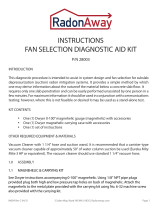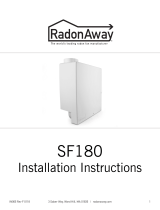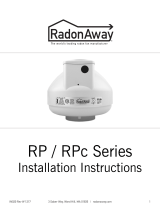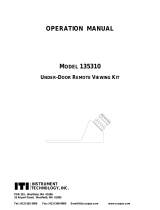Page is loading ...

IN141 Rev A 13 Saber Way, Ward Hill, MA 01835 | radonaway.com
Installation & Sampling
RadonAway RVI Test Port

IN141 Rev A 23 Saber Way, Ward Hill, MA 01835 | radonaway.com
The RadonAway Radon and Vapor Intrusion (RVI) Test Port is designed to be a low-cost, quick and easy way
to conduct sub-slab differential pressure measurements and soil gas sampling beneath a concrete slab. The
system consists of three components; a Port, Port Cap and a Port Installation/Cap Removal Tool which can
be installed as a temporary or permanent sample point. This product is made from durable polyethylene
plastic and has been designed to stand up to typical building traffic. Note: Check RVI Test Port’s chemical
compatibility with the known or suspected chemical(s) present at your project site (refer to Page 4 for a
partial Chemical Resistance Chart).
This instruction describes the installation and usage of the RVI Test Port system for use in pressure field
extension testing and soil gas sampling.
EQUIPMENT REQUIRED
• RVI Test Port
• RVI Cap
• RVI Installation/Cap Removal Tool
• Rotary Hammer Drill
• ½” Diameter Hammer Bit
• Wet/Dry Vacuum with HEPA Filter (recommended)
• Radon Pro PGS Sealant
• ¼” Screwdriver (if closing out the port location)
• Lightweight Hammer (if closing out the port location – See Port Hole Closure Section)
• Hole patching material (hydraulic cement or RadonAway Pro Sealant and a putty knife or trowel (for repairing the hole if the
RVI Test Drill Hole)
INSTALLATION PROCEDURE
1. Check for buried obstacles (pipes, electrical lines, etc.)
prior to drilling hole in concrete floor.
2. Set up wet/dry vacuum to collect drill debris and dust.
Drill a ½” (13mm) diameter hole completely through
the concrete slab into the sub base material. The hole
must be ½” (13mm) in diameter to ensure a seal
around the RVI Test Port (Photo 1).
3. Remove the drill bit, and remove the loose debris and dust
from the hole and surrounding concrete surface using
the vacuum.
4. Place a bead of RadonAway Pro Sealant around the RVI
Test Port (Port) at a point near the center of the ribbed
section of the port (Photo 2).
5. Place the lower end of the Port into the drilled hole. Using
the side of the Port Installation/Cap Removal Tool (Tool)
that has the flat surface with the protruding pin (Photo 3)
into the top (large) end of the Port so that the tool’s flat
surface is flush with the top edge of the Port (Photo 4).
Installation & Sampling
Radonaway RVI Test Port
Please Read and Save These Instructions.
PORT
TOOL
CAP
1 2
3 4

IN141 Rev A 33 Saber Way, Ward Hill, MA 01835 | radonaway.com
6. Push the tool to the floor until the tool and Port is flush with
floor (Photo 5). Make sure the Tool is aligned parallel to the
Port to avoid damaging the port. If port cannot be pushed
flush to the floor by hand, use a hammer to tap the top flat
part of tool. Wipe up any excess visible caulk from around
port or on the tool.
7. Place the RVI Cap (Cap) on the Port while not being used for
sub-slab differential pressure measurements or soil gas
sampling (Photo 6).
CAP REMOVAL / RE-INSTALLATION PROCEDURE
1. Using the “+” side of the Tool (Photo 7), insert the “+” end into the Cap and twist from side to side several times to make
sure that the Cap is loose for subsequent removal (Photo 8).
2. Using the “wedge” side of the Tool (Photo 9), slide the wedge between the Cap and the concrete floor and slowly pry moving
the Tool around the Cap lip to several locations until the Cap is completely free of the Port (Photo 10).
3. Prior to re-installing, make sure Cap is free of dirt and debris in order to ensure that the Cap does not become bound to the
Port.
TESTING / SAMPLING PROCEDURE
Remove the Cap using the Tool and push ¼” outside
diameter (O.D.) flexible tubing into the open hole at the top
of the Port (Photo 11). The tubing should go into the Port
approximately ½” or until snug to ensure a proper seal.
4. Connect tubing to appropriate testing or sampling devices to
be used.
5. Upon completion of test / sampling, disconnect tubing from
the Port and re-nstall Cap (Photo 12).
5 6
7 8
109
11 12a12b

IN141 Rev A 43 Saber Way, Ward Hill, MA 01835 | radonaway.com
PORT HOLE ABANDONMENT AND CLOSURE
If the port has been installed as a temporary testing location, the port may be abandoned by pushing the port further into the drill
hole a minimum of 2” using a 3/16” flathead screwdriver and hammer.
To complete abandonment – fill the ½” drill hole with a hole patching material (e.g., hydraulic cement or RadonAway Pro
Sealant until flush with the surrounding surface elevation.) Use a putty knife or trowel to smooth the surface.
POLYETHYLENE CHEMICAL COMPATIBILITY CHART (PARTIAL LIST)
CHEMICAL POLYETHYLENE
RESISTANCE*
DIESEL C
ETHYLENE GLYCOL A
FUEL OIL (1, 2, 3, 5A, 5B, 6) B
GASOLINE A
HYDRAULIC OIL (PETRO) C
HYDRAULIC OIL (SYNTHETIC) A
JET FUEL (JP3, JP4, JP5) D
LUBRICATING OIL A
KEROSENE C
MOTOR OIL C
NAPHTHALENE C
PETROLEUM C
TRANSFORMER OIL C
BENZENE C
DICHLOROETHANE C
ETHANOL B
KETONES C
METHANOL A
MEK D
METHYLENE CHLORIDE D
MINERAL SPIRITS B
PERCHLORETHYLENE D
PAFFAFIN B
XYLENE B
AROMATIC HYDROCARBONS C
TOLUENE C
A – No Effect – Excellent
B – Minor Effect – Good
C – Moderate Effect – Fair
D – Sever Effect – Not Recommended
*Ratings of chemical behavior listed in this
chart apply at a 48‐hr exposure period. These
recommendations are based upon information
from material suppliers and careful examina-
tion of available published information and
are believed to be accurate. However, since
the resistance of plastics can be affected by
concentration, temperature, presence of other
chemicals and other factors. This information
should be considered as a general guide
rather than an unqualied guarantee.
Ultimately, the customer must determine
the suitability of the product material of
construction used in various solutions.
/








